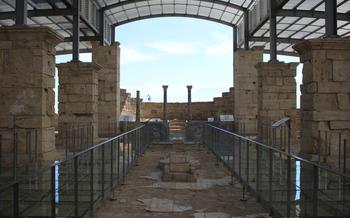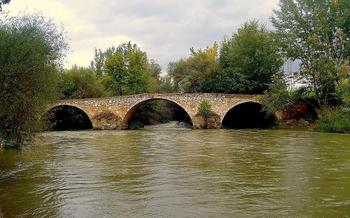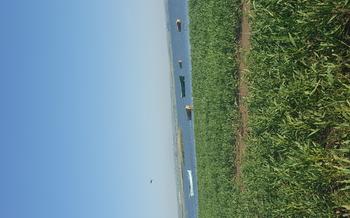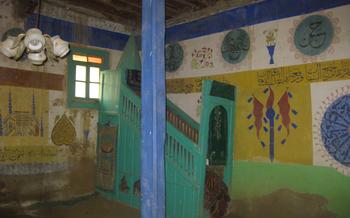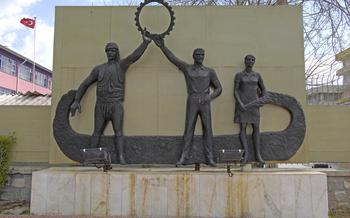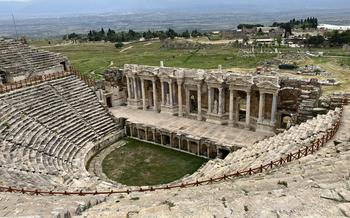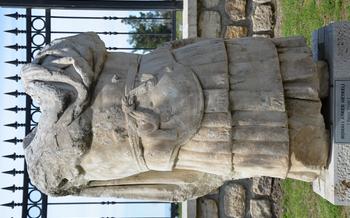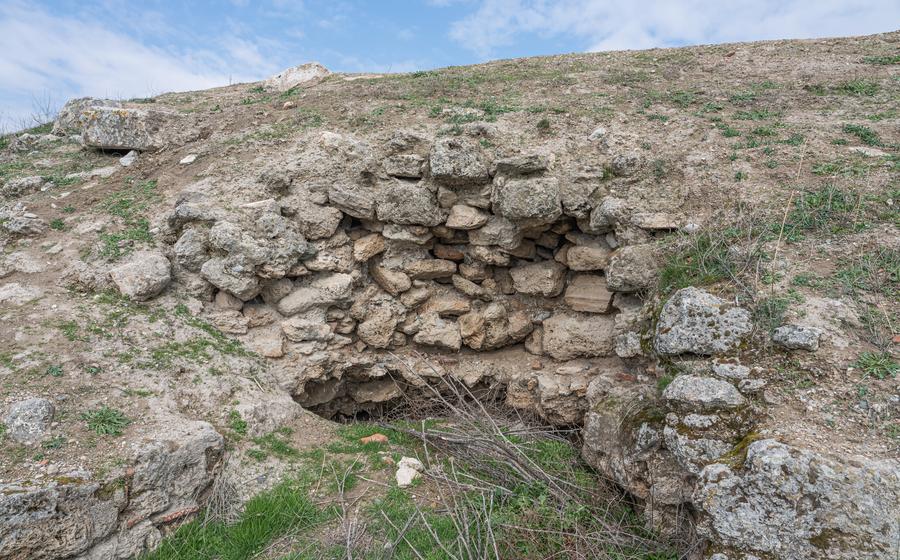
Colossae Ancient City
- Exploring the Ruins of Colossae
- The Necropolis of Colossae
- The Acropolis of Colossae
- The Colossae Letter and the Apostle Paul
- Hiking to Colossae: A Scenic Adventure
- Laodicea: A Neighboring Ancient City
- Hierapolis: A UNESCO World Heritage Site
- Pamukkale Travertines: A Natural Wonder
- Karahayit Hot Springs: A Relaxing Getaway
- Denizli Cuisine: A Culinary Delight
- Accommodation in Denizli: A Range of Options
- Transportation in Denizli: Getting Around
- Safety Tips for Travelers in Denizli
- Insider Tip: Discovering Hidden Gems
Exploring the Ruins of Colossae
Colossae was once a bustling city, and its ruins offer a glimpse into its rich history and culture. The city walls and gates, which once protected the city from invaders, still stand tall in some sections. The agora, or marketplace, was the center of commercial activity, and the bouleuterion, or council building, was where the city's leaders met to discuss and make decisions.
The theater and odeon, used for entertainment and performances, are impressive structures that have been partially restored. The Temple of Apollo, dedicated to the Greek god of music and poetry, is one of the most significant religious structures in Colossae. Its ruins include well-preserved columns and intricate carvings.
Other religious structures, such as churches and temples, can also be found scattered throughout the site, reflecting the diverse religious beliefs of the city's inhabitants. Exploring the ruins of Colossae is like stepping back in time, offering visitors a unique opportunity to witness the grandeur of this ancient city.
The Necropolis of Colossae
Located just outside the city walls, the Necropolis of Colossae is a fascinating glimpse into the ancient burial practices of the city's inhabitants. The necropolis is home to a variety of tombs, ranging from simple rock-cut graves to elaborate structures with intricate carvings and inscriptions.
One of the most notable tombs is the Tomb of the Archpriest, which features a large chamber with a vaulted ceiling and a number of niches for burials. The tomb is also decorated with a variety of reliefs, including depictions of the deceased and scenes from Greek mythology.
Another interesting tomb is the Tomb of the Athlete, which features a life-size statue of a young athlete holding a discus. The tomb also contains a number of inscriptions, which provide information about the athlete's life and achievements.
The Necropolis of Colossae is a valuable source of information about the ancient city and its people. The tombs provide insights into the religious beliefs, social customs, and artistic traditions of the Colossians. The necropolis is also a beautiful and atmospheric place to visit, offering visitors a chance to connect with the past in a truly unique way.
The Acropolis of Colossae
Located on a hilltop overlooking the ancient city, the Acropolis of Colossae offers breathtaking views of the surrounding area. The acropolis was once a fortified citadel, protecting the city from invaders. Today, visitors can explore the remains of the fortifications, including towers, walls, and gates. The Church of St. Michael, a Byzantine church built in the 6th century, is another highlight of the acropolis. The church features beautiful frescoes and mosaics depicting scenes from the Bible. Within the acropolis, there are also traces of other Byzantine structures, such as a monastery and a cistern. Additionally, an Ottoman fortress was built on the acropolis during the 15th century, further adding to the site's historical significance.
The Colossae Letter and the Apostle Paul
The Colossae Letter and the Apostle Paul
The ancient city of Colossae gained significant biblical importance due to its association with the Apostle Paul and the letter he wrote to the Colossians. The Apostle Paul played a crucial role in spreading Christianity throughout the Roman Empire, and Colossae was one of the cities he visited during his missionary journeys. His letter to the Colossians, written around 60-62 AD, is included in the New Testament of the Bible.
In his letter, Paul addressed various theological and ethical issues relevant to the early Christian community in Colossae. He emphasized the supremacy of Christ, warning against false teachings and encouraging the Colossians to live according to Christian principles. The letter highlighted themes such as the deity of Christ, the redemption through his death and resurrection, and the importance of unity and love within the church.
The Colossae letter provides valuable insights into the early development of Christianity and the challenges faced by the early church. It also sheds light on the life and teachings of the Apostle Paul, who played a pivotal role in shaping the beliefs and practices of the Christian faith.
Hiking to Colossae: A Scenic Adventure
Colossae, an ancient city in Denizli, Turkey, invites intrepid hikers to embark on a scenic journey through history and nature. The hike to Colossae offers two captivating trails: one from Honaz and the other from Laodicea.
The Honaz trail is a moderate hike, taking approximately 3-4 hours, and rewards hikers with breathtaking panoramic views of the region. Passing through lush forests and ancient ruins, this trail leads to the heart of Colossae, where history comes alive.
The Laodicea trail, a challenging but rewarding hike, takes 4-5 hours and immerses hikers in the wonders of the Lycus Valley. Traversing rugged terrain and passing by cascading waterfalls, this trail offers a unique perspective of the ancient world.
Along both trails, hikers are greeted by stunning scenery, including majestic mountains, verdant valleys, and the meandering waters of the Lycus River. The trails offer opportunities to explore hidden caves, ancient inscriptions, and remnants of past civilizations.
To ensure a safe and enjoyable hiking experience, it is advisable to wear appropriate footwear, carry sufficient water and snacks, and be prepared for changes in weather conditions. Respecting the fragile ecosystem and local customs is essential while hiking in this region.
Colossae awaits those who seek adventure and a glimpse into the past. Whether hiking from Honaz or Laodicea, the journey to Colossae is an unforgettable experience, combining the thrill of exploration with the beauty of the natural world.
Laodicea: A Neighboring Ancient City
Laodicea, an ancient city in Denizli, lies 10 kilometers southeast of Colossae. Founded by the Seleucid king Antiochus II Theos in the 3rd century BC, it was a thriving center of trade and commerce. The city's strategic location on the trade routes connecting the Aegean coast with the interior of Anatolia contributed to its wealth and prosperity.
Laodicea boasts impressive ruins and attractions that draw visitors interested in ancient history and archaeology. Among the notable ruins are the well-preserved city walls, the impressive theater, and the remains of the agora, where commercial activities once took place. The city's aqueduct system, which brought water from a distance of 17 kilometers, is a testament to the engineering prowess of its builders.
The Laodicea Church holds particular significance for Christians. Mentioned in the Bible's Book of Revelation, it was one of the seven churches of Asia. The church played a crucial role in the spread of Christianity in the region.
The connection between Laodicea and Colossae was strong, as evidenced by the presence of a road connecting the two cities. The Apostle Paul, who wrote the letter to the Colossians, likely traveled between these cities during his missionary journeys.
Hierapolis: A UNESCO World Heritage Site
Located just 20 kilometers from Colossae, Hierapolis is another ancient city that boasts UNESCO World Heritage status. Founded in the 2nd century BC by King Eumenes II of Pergamon, Hierapolis flourished as a spa town and religious center. Visitors today can marvel at the well-preserved ruins, including the imposing Roman theater, the Temple of Apollo, and the spectacular Necropolis.
The highlight of Hierapolis, however, is undoubtedly the Pamukkale Travertines. These unique natural formations, composed of white calcium carbonate terraces, cascade down the hillside like a frozen waterfall. The travertines were formed by the hot springs that have been flowing from the earth's crust for centuries, depositing minerals and creating a surreal landscape that has to be seen to be believed.
Hierapolis and Pamukkale are easily accessible from Denizli, with regular buses and tour operators offering day trips. Whether you're interested in ancient history, natural wonders, or simply relaxing in the hot springs, a visit to Hierapolis is an absolute must.
Pamukkale Travertines: A Natural Wonder
Pamukkale Travertines are a unique and breathtaking natural wonder located in Denizli, Turkey. These dazzling white terraces, formed by the deposition of calcium carbonate from hot springs, have been declared a UNESCO World Heritage Site due to their exceptional beauty and geological significance.
The travertines, meaning "cotton castle" in Turkish, cascade down the hillside like a frozen waterfall, creating a surreal and magical landscape. The terraces are filled with warm, mineral-rich water that flows gently from one level to another, creating a soothing and relaxing atmosphere.
Visitors can walk along the travertines, marveling at the intricate patterns and colors created by the mineral deposits. The warm waters are also known for their therapeutic properties, and many people come to Pamukkale to soak in the pools and enjoy the healing benefits of the mineral-rich waters.
In addition to the travertines, Pamukkale is also home to the ancient city of Hierapolis, which was founded in the 2nd century BC. The ruins of the city, including an impressive amphitheater, temples, and baths, are scattered throughout the travertines, adding to the site's historical and cultural significance.
For a truly unforgettable experience, visitors can take a hot air balloon ride over Pamukkale at sunrise, witnessing the stunning panorama of the travertines and the surrounding countryside bathed in the golden light of the morning sun.
When visiting Pamukkale, remember to bring comfortable shoes for walking on the travertines, a swimsuit if you plan to bathe in the pools, and sunscreen to protect yourself from the sun. Also, be aware that the travertines can be slippery, so it's essential to exercise caution and follow the designated paths.
Karahayit Hot Springs: A Relaxing Getaway
Nestled amidst the picturesque landscapes of Denizli, the Karahayit Hot Springs offer a tranquil retreat for weary travelers and locals alike. With a rich history dating back to ancient times, these hot springs have been renowned for their therapeutic and healing properties. Visitors can immerse themselves in the warm, mineral-rich waters, which are believed to alleviate various ailments, including rheumatism, skin conditions, and muscle pain.
The surrounding natural beauty complements the rejuvenating experience. Lush greenery, towering mountains, and cascading waterfalls create a serene ambiance, inviting visitors to connect with nature and embrace the tranquility of the surroundings. Whether seeking relaxation, rejuvenation, or a unique spa experience, the Karahayit Hot Springs provide an idyllic escape from the bustling city life.
Denizli Cuisine: A Culinary Delight
Denizli's cuisine is a delectable blend of Turkish and regional flavors, showcasing the city's rich cultural heritage. From traditional dishes to modern culinary creations, Denizli offers a diverse culinary experience for food enthusiasts.
Local Dishes and Specialties:
-
Indulge in the tantalizing flavors of "kebap," a grilled meat dish that is a staple of Turkish cuisine. Denizli's version is renowned for its tender meat and aromatic spices.
-
Savor the succulent "lahmacun," a thin flatbread topped with minced meat, vegetables, and herbs, baked in a traditional stone oven.
-
Delight in "mantı," delicate dumplings filled with minced meat and yogurt sauce, a local favorite that bursts with flavor in every bite.
-
Don't miss the chance to try " keşkek," a hearty dish made from pounded wheat, meat, and spices, cooked slowly in a clay pot for an unforgettable taste.
Restaurants and Cafes in Denizli:
-
Explore the vibrant restaurant scene in Denizli, from traditional Turkish eateries to modern fusion restaurants.
-
Indulge in a leisurely breakfast at one of the many cafes, savoring the aromatic Turkish coffee and freshly baked pastries.
-
Head to the Denizli bazaar for a culinary adventure, where you can sample local delicacies and street food from vendors.
Tips for Food Lovers and Vegetarians:
-
Be adventurous and try new dishes, embracing the local flavors and culinary traditions.
-
Ask locals for recommendations on authentic restaurants and hidden culinary gems.
-
Vegetarians will find plenty of options, as Turkish cuisine offers a wide variety of vegetable-based dishes.
-
Don't forget to try the local wines, which are produced in the Denizli region and offer a unique taste experience.
Accommodation in Denizli: A Range of Options
Denizli offers a wide range of accommodation options to suit different budgets and preferences. From luxurious hotels to budget-friendly hostels, there's something for every traveler.
For a comfortable and convenient stay, consider booking a room at one of the many hotels located in the city center. These hotels often provide modern amenities, such as air conditioning, Wi-Fi, and room service. For a more affordable option, guesthouses and hostels are a great choice. These establishments offer basic accommodations and a chance to socialize with other travelers.
If you're looking for a unique and immersive experience, consider camping or staying in one of the many outdoor accommodations available in the region. This is a great way to connect with nature and enjoy the stunning scenery of Denizli.
To find the best accommodation for your needs, it's a good idea to book in advance, especially during the peak tourist season. Online booking platforms and travel agencies can help you compare prices and find the best deals.
Transportation in Denizli: Getting Around
Denizli is well-connected by air, land, and public transportation, making it easy to get around and explore the city and its surrounding attractions.
The Denizli Çardak Airport (DNZ) is located about 60 kilometers from the city center and offers domestic flights to major cities in Turkey, as well as international flights to select destinations. From the airport, you can take a taxi or rent a car to reach the city center or other destinations in the region.
Public transportation in Denizli is efficient and affordable, with a network of buses and minibuses that connect the city center to various neighborhoods and nearby towns. You can purchase a DenizliKart, a rechargeable transportation card, to use on public buses and minibuses, making it a convenient and cost-effective way to get around.
Renting a car can be a great option for those who want the flexibility to explore the region at their own pace. Several car rental companies are available at the airport and in the city center, offering a range of vehicles to choose from. Be sure to have an international driver's license and familiarize yourself with the local traffic regulations before driving in Turkey.
Taxis are readily available in Denizli and can be hailed on the street or ordered through a taxi app. Taxis are generally metered, but it's advisable to agree on a fare before getting in the car to avoid any misunderstandings.
Safety Tips for Travelers in Denizli
Denizli is a generally safe city for travelers, but as with any destination, it's essential to be aware of your surroundings and take necessary precautions. Here are some safety tips to keep in mind:
-
General safety and precautions: Avoid walking alone at night, especially in secluded areas. Be cautious of pickpockets and petty theft, particularly in crowded places. Keep your valuables safe and don't flash expensive items in public.
-
Avoiding scams and tourist traps: Be wary of unsolicited offers for tours or services, especially from people who approach you on the street. Research reputable tour operators and guides before booking any excursions. Avoid money-changing scams by using authorized exchange bureaus or banks.
-
Dealing with language barriers and cultural differences: Learn a few basic Turkish phrases to help communicate with locals. Be respectful of Turkish customs and traditions, such as removing your shoes before entering a mosque.
-
Tips for solo travelers and women travelers: If traveling alone, consider joining group tours or activities to meet other travelers. Dress modestly and avoid revealing clothing to avoid unwanted attention. Be assertive and confident when dealing with strangers.
Insider Tip: Discovering Hidden Gems
Beyond the popular attractions, Denizli offers a wealth of hidden gems waiting to be discovered by curious travelers. Explore the picturesque villages nestled amidst rolling hills, each with its unique charm and traditions. Visit the local bazaars and markets to immerse yourself in the vibrant atmosphere and find one-of-a-kind handicrafts. Take a cooking class to learn the secrets of traditional Turkish cuisine and savor the flavors of authentic dishes. Embark on a hot air balloon ride over the stunning landscapes of Cappadocia, offering a breathtaking perspective of the region's natural wonders. For an unforgettable experience, join a local festival or event to witness the vibrant cultural heritage of Denizli, where music, dance, and traditional performances come alive. Whether you seek adventure, culinary delights, or cultural immersion, Denizli offers a myriad of hidden treasures to satisfy your wanderlust.
